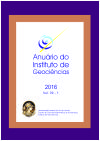Contribution to the Characterization of Paiaguás's Pantanal
DOI:
https://doi.org/10.11137/2016_1_32_41Keywords:
Pantanal, Geotechnologies, Structural lineamentsAbstract
The Pantanal is a wetland with the highest wealth of biodiversity in Brazil, covering part of the territory of Brazil, Paraguay and Bolivia. It presents inner features implying in several sub regions called Pantanais. In the literature, there are several subdivisions considering from 10 to 18 regions and total area from 133,465 to 168,000 km2. The aim of this work is to contribute in the delimitation of Pantanal of Paiaguás through different geotechnologies. It was used open source softwares, satellite images (Landsat 8), digital surface model, hydrographic net and structural lineaments. The criteria adopted in the delimitation were based on flood, altimetry, hydrology, vegetation and geological-structural patterns. The main results was the Pantanal of Paiaguás delimitation with 17,808 km2, which differs from other limits in the literature, mainly for not considering inside the Pantanal of Taquari and due to the different materials and methodology used in previous work.Downloads
Download data is not yet available.
Downloads
Published
2017-02-15
How to Cite
Mioto, C. L. (2017) “Contribution to the Characterization of Paiaguás’s Pantanal”, Anuário do Instituto de Geociências. Rio de Janeiro, BR, 39(1), pp. 32–41. doi: 10.11137/2016_1_32_41.
Issue
Section
Article
License
This journal is licensed under a Creative Commons — Attribution 4.0 International — CC BY 4.0, which permits use, distribution and reproduction in any medium, provided the original work is properly cited.















